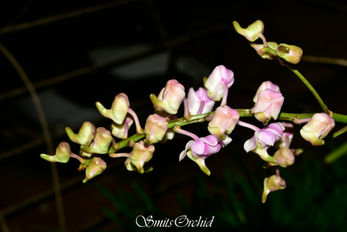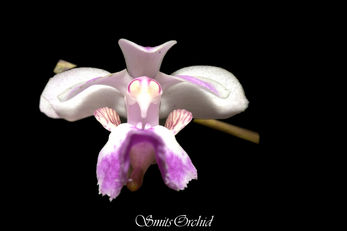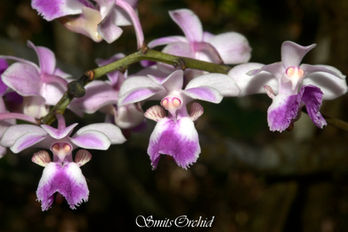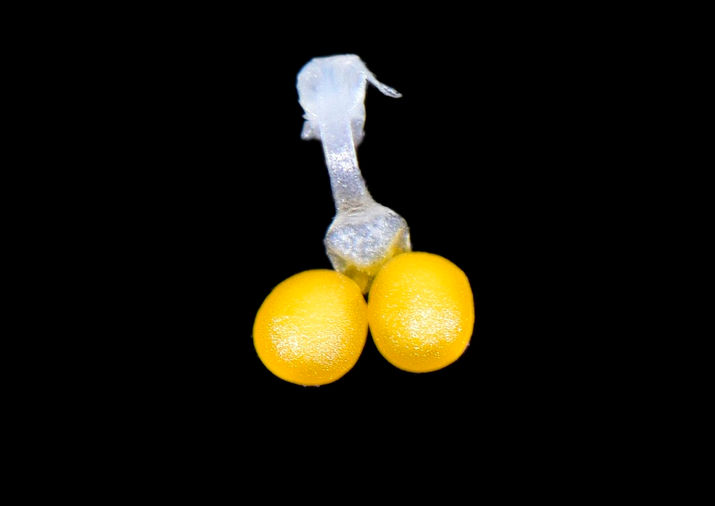
Aerides Lour.
Sub Class Epidendroideae
Tribe Vandeae
Sub tribe Aeridinae
Derivation of name From the Latin aer-, air, and the suffix -idus, having the nature of, in reference to the epiphytic habit.
Salient Features
-
Epiphytic herb
-
Stem enclosed by leaf sheaths
-
Leaves linear oblong distichous, apex bilobed, leaf base sheathing
-
Inflorescence Racemose or paniculate, pendent, densely many flowered
-
Flowers showy
-
Sepals & Petals similar broad spreading Lateral sepals decurrent on column foot; petals smaller than sepals
-
Labellum trilobed, spurred, immobile continuous with column foot; side lobes decurrent on column, mid lobe erose
-
Spur narrowly conical or horn shaped
-
Column elongate, broadened at the apex, foot distinct; anther cap two celled beaked; pollinia two waxy, subgloular unequally cleft; attached to semicircular viscidium by long slender stipe; rostellum well developed
-
Genus Aerides is represented by two species at Sindhudurg district

Aerides crispa Lindl.
In Gen. Sp. Orchid. Pl.: 239 (1833)
-
Aerides brockesii Lindl. ex Heynh. in Alph. Aufz. Gew.: 11 (1846), orth. var.
-
Aerides brookei Bateman in Edwards's Bot. Reg. 27(Misc.): 55 (1841)
-
Aerides crispa var. lindleyana (Wight) A.H.Kent in H.J.Veitch, Man. Orchid. Pl. 7: 66 (1891)
-
Aerides crispa var. warneri A.H.Kent in H.J.Veitch, Man. Orchid. Pl. 7: 66 (1891)
-
Aerides lindleyana Wight in Icon. Pl. Ind. Orient. 5: 1677 (1851)
-
Aerides warneri Hook.f. in Fl. Brit. India 6: 46 (1890), pro syn.

Ecology Epiphyte on Careya arborea, Catunaregam spinosa, Euphorbia neriifolia, Memecylon umbellatum, Diospyros sp. Sometimes lithophytic in evergreen forest
Stems 1-2 cm thick, sheathed.
Leaves 7-24 X 1.6-3cm, thickly coriaceous, rarely channelled, Oblong, pale green with a purplish tinge at the base, with 2 unequal rounded lobes at the apex.

Inflorescence 10-30 cm long, erect or drooping, rarely branched; peduncles 2-4 mm thick, brown with a few small closely appressed sheaths.

Flowers about 3 cm across, bracteate, pedicellate strongly and sweetly scented especiIally when fresh.
Bracts 5 X 5 mm, semi-amplexicaul, triangular-ovate, acute, entire, scabrid, brown, 3-nerved.
Pedicel with ovary 1.7 cm long, straight or slightly curved, faintly ribbed, rose-pink.

Sepals spreading, minutely denticulate, acute-mucronulate, glabrous, faintly 9-nerved; lateral sepals 16 X 12 mm, obliquely oblong, pinkish white tinged with mauve towards the apex, more so on the back; dorsal one 15 X 10 mm, oblong-suborbicular, pinkish white with a broad, mauve patch on the back.

Petals 16 X 10 mm, spreading in the same plane as the sepals, obovate-orbicular, rarely suboblique, acute, mucronulate, minutely denticulate, faintly 7-nerved.

Labellum 28 mm long, 3 lobed, very shortly clawed, somewhat geniculately inflexed at the claw; lateral lobes yellowish with purple coloured strips; 5 X 3-4 mm, oblong, obtuse, entire or slightly crenulate, more or less spreading, but erect at the base, with a somewhat square hollow which leads to the spur ; the entrance to the spur being somewhat arched over by 2 fleshy, pinkish white subconical calli, lying back to back with their apices diverging; midlobe 22 X 20 mm, pink-mauve, deeper than the sepals and petals, broadly ovate, 5-7 mm broad at the apex, retuse ; margins deflexed, finely crisped, crenulate.
Spur 10 X 4 mm, inflexed from below the lateral lobes, proceeding under the mid. lobe, obtuse, pale mauve-pink.

Column 6 X 5 mm, oblong, subclavate produced at right angles into a 10 X 6 mm obcuneate-oblong foot, on which the lip somewhat articulates.
Anther 6 X 5 mm, oblong with 2 mm long beak, pale yellow with a purple ring round the margins; pollinia 2, yellow, waxy, globose; caudicle 3 mm long, and ensheathed by a gland 2 mm long. Stigmatic surface 4 X 2 mm, elliptic-orbicular.

Capsules 3-3.5 cm long, oblong-elliptic, strongly ridged; pedicels about 1.5 cm long, slightly curved.
Flowering: May to June.
Fruiting: July onwards























